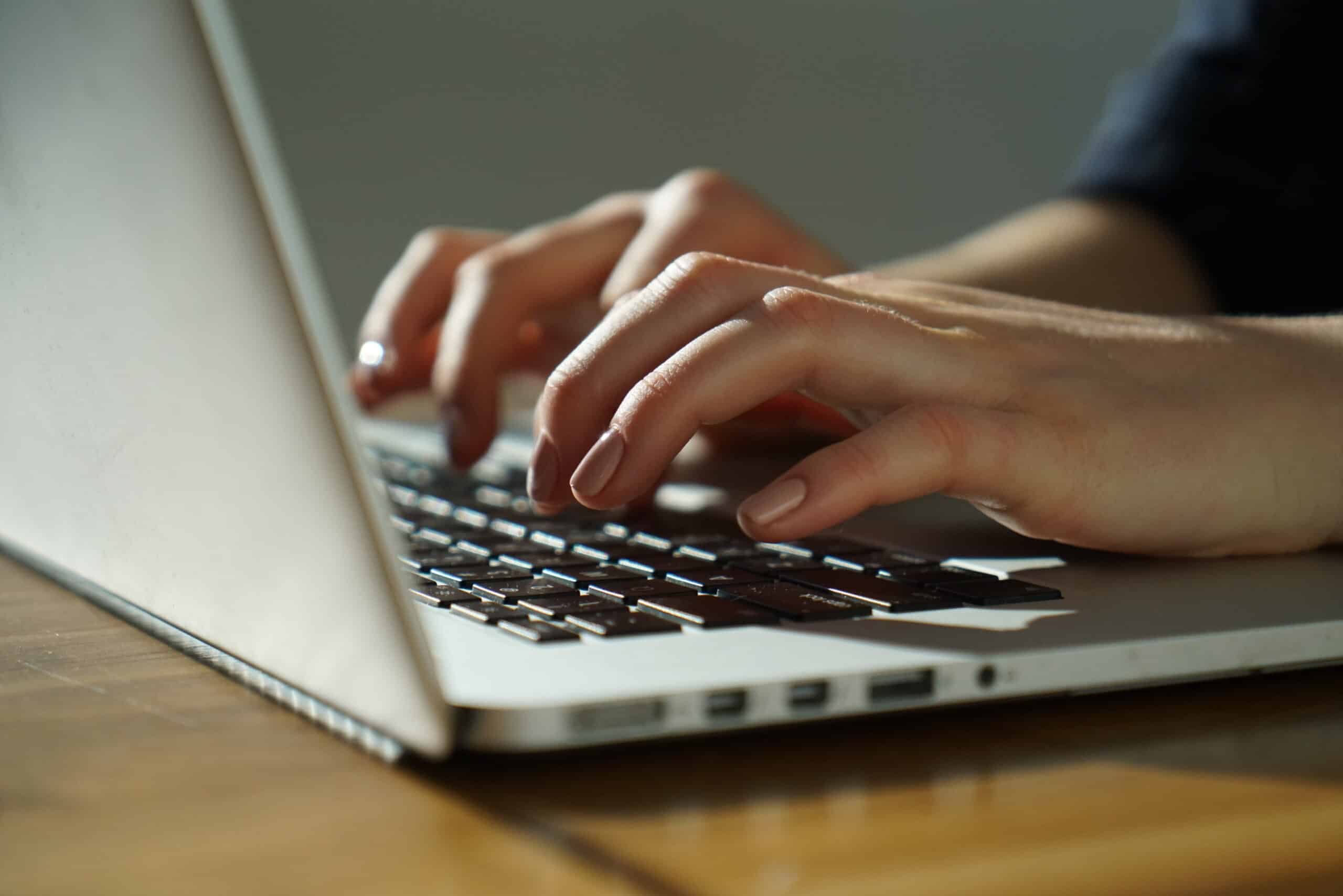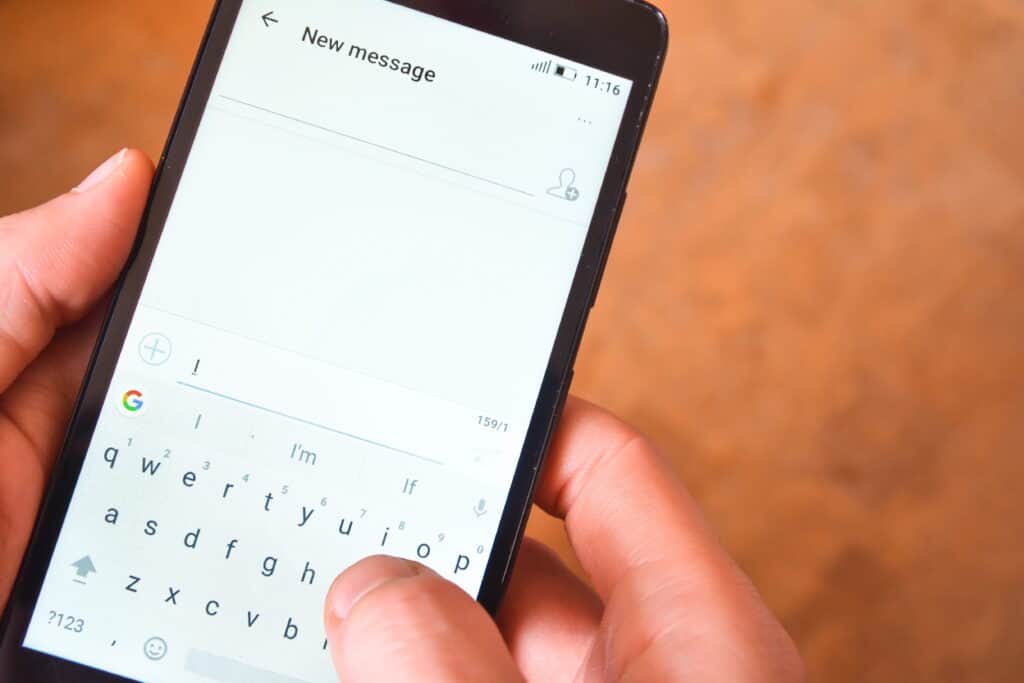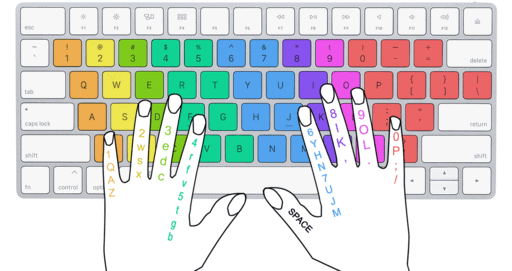One of the most used skills in today’s world is- Typing. However, most people still struggle with using two fingers to type on the Keyboard.
For devices like laptops, using only two fingers can delay the pace of your work and disrupt the overall ease of using a keyboard.
When I was in high school, I decided to stop using two fingers for typing on the Keyboard.
With the help of online typing tests and practices, I learned touch typing. And frankly speaking, it has never gone to waste.
Typing with two fingers (hunt and peck approach) is not advised. Using fewer fingers can interfere with focus, limit movement, and increase errors. It also puts strain on your wrists and reduces WPM (words per minute) count.

Everyone has their style of typing with which they feel comfortable. Therefore, it is not always necessary to use the exact fingers for the same set of keys on a keyboard.
However, it should be noted that just knowing how to use a QWERTY keyboard with all fingers can make you seem more professional and sleek.
In this article, we will discuss all typing with two fingers- Is it appropriate to do so? Why and why not? How can we improve our typing skills?
Stay tuned to learn more.
Table of Contents Show
What is Typing with Two Fingers Called?
“Hunt and peck” is the method of using two fingers for typing. It is a rather widespread typing method, mostly for beginners.
The typist presses keys on a keyboard with the index fingers, usually without a memorized pattern of the keys.
As the name suggests, the typists need to Hunt for the keys by sight essentially.
This method causes errors since the typist can’t fully concentrate on what has been typed. Rather, a person uses the brain to search for the keys.
Why is it Inappropriate to Type with Two Fingers?
So, why should you learn to touch type with all ten fingers when you can get by with just two?
Here are some of the most basic reasons why typing with two fingers is not recommended.
1. More Errors
When using two fingers, you have to glance at the keys a lot more, which means you’re less likely to detect mistakes on the screen as you type.
All your focus is on detecting the keys and pressing multiple with the same finger.
Ultimately, it takes longer for you to go back and check your work after you’re done.
Two-finger typists may type two keys instead of one or push one key several times. Moreover, they may not notice the text cursor pointed at the wrong place.
Have you ever noticed how you tend to type more errors on the phone than using a laptop?
Studies show that more word suggestions are used in phones, linking the idea of fewer fingers being used on the phone.

On the other hand, touch typing allows you to read and correct simultaneously.
And, it’s much better for transcribing and taking notes from the board.
The QWERTY keyboard is designed so that the most frequent letter patterns in English can be typed with ease. So, touch typing with all ten fingers is speedier and more practical.
2. Average Typing Speed Decreases
While using two fingers, your gaze is not directed to a single place. This makes it tiresome for your brain, eyes as well as your fingers.
There is also a greater chance of getting lazy while you type for longer content.
Moreover, it gets harder to match typing with your thinking pace, reducing your ability to put down all ideas going in your mind.
The typing speed of a typist using two fingers is 27 words per minute (WPM) while touch-typing allows you to write up to 40 to 60 words per minute (WPM).
While typing a research paper or a presentation, using two fingers can decrease your attention, leading to delayed work.
To put it another way, learning to touch type now is preferable to relearning typing altogether later on.
Moreover, if you position your Keyboard well, your speed increases even more and causes less fatigue.
Read more on: Should You Tilt Your Keyboard While Typing?
3. Lack of Professionalism
In today’s world, filing, typing up mail, creating reports, and working on electronic documents are unavoidable. They are needed in every role.
When time is money, workers using the hunt-and-peck method will be noticeably slower than their peers.
As a result, companies that value time may choose to reward quicker typists with more work or more pay.
Being able to type smoothly makes you seem professional and focused at work.
However, poor typing skills appeal to many employers even if you are great at your job.

Secretarial professions, assistant roles, transcription, data entry, journalists, emergency services operators, software engineers, and even court case recorders require a good WPM count.
There may be a requirement for applicants to take a timed typing test for some jobs.
The Research shows us the wide variety of benefits of ten-finger typists, ranging from better speed to accuracy. All these can elevate any work environment drastically.
4. Difficult to Build Muscle Memory
When the movements necessary to type words get automated over time, typing becomes a fluid transfer of thoughts into language.
This is best for authors as they need to put their ideas out without ruining the feel and texture of the content.

But, it takes a long time to develop muscle memory using two fingers. This is because fewer fingers have to memorize longer patterns.
When you commit to touch typing, you save brain energy by not having to think about each letter as you write it.
Muscle memory makes working tremendously calming and satisfying when your fingers instantly know where to go.
5. It May Lead to Physical Injuries
Two-finger typists are more likely to have wrist discomfort and finger injuries. This is because two-finger typists float their hands above the Keyboard rather than rest them.
Similarly, they tend to tense their fingers when searching for keys. But, again, it is a subconscious act only realized when numbness and tingling are felt.

Carpal tunnel syndrome is an uneasy pain that affects the hand and wrist, causing discomfort, numbness, tingling, and weakness.
Similarly, cubital tunnel syndrome also produces tingling and numbness in the fingers.
Again, however, it arises when nerves in the elbow, rather than the wrist, become constricted.
Repetitive Strain Injury (RSI) is a moderate to severe ailment caused by doing repetitive tasks with the hands, such as typing, clicking a mouse, or writing. Poor posture, technique, and overuse are the three main risk factors.
Hence, the repetitive act of flexing fingers to reach keys and strain put on your forearm can have long-term deliberating effects.
If you feel discomfort and numbness from typing, you might want to see our article linked below.
Discover more: Should You Use Armrest While Typing?
Why can I Type with Only Two Fingers?
If you think typing with two fingers is the ideal approach, you’re not alone.
Some people find it far simpler to type with only two fingers and attain the same speed as those who use all ten digits.
Self-taught typists don’t use each of their fingers on just their designated keys.
This may be attributable to not everyone having hands with perfect fingers.
Some have small fingers, and some have more mobility with a few fingers, making it difficult to reach certain keys with a single finger.
For example- Most people find it difficult to reach keys with the ring and pinky fingers. Studies show that typing speed can be linked to the length of fingers.
Research done by Vanderbilt University discovered that nonstandard typists rely on their vision much more than standard typists.
When the Keyboard was blocked, the speed and accuracy of the nonstandard typists dropped while that of the standard typists remained about the same.
So, typing with two fingers is acceptable, but it may cause strain; instead, try typing with three fingers or more.
If you don’t need to glance at the Keyboard and achieve a good pace using just two fingers, then go for it. However, if this is difficult, then try incorporating more fingers.
Average Typing Speed Vs. Number of Fingers
According to a survey, more people can touch type without looking at the Keyboard than two-finger typists. This indicates that it is gradually getting more popular.
Here’s a comparison chart based on typing speed and the number of fingers used.
| Factors | 2 fingers | 4 fingers | 10 fingers |
|---|---|---|---|
| Speed | 27-37 WPM | 30-40 WPM | 40 and 60 WPM |
| Accuracy | 85% | 90% | 95% |
| Viewing the keyboard | Maximum | Less in comparison to two finger typists | Minimum |
| Wrist pain | Increased risk of carpal tunnel syndrome | Less pain compared to two finger typists | Decreased risk of wrist injury |
What is Touch Typing?
Alternative to the hunt-and-peck method, the “Touch typing” method is more efficient and standardized.
In this system, we rest the four fingers of our hand on the home row while the thumb rests on the spacebar.
Then, every time we type, we move the fingers that are needed. With enough muscle memory, this method helps us type without even glancing at the Keyboard.

Learning how to touch type is the most useful tool in increasing typing speed and accuracy.
Touch typing allows you to make fewer mistakes and minimizes glances at the Keyboard.
Hence, you gain more speed while touch typing than using two fingers.
Furthermore, having more fingers will help you reduce the stress of frequent wrist movements in the long term.
Related article: What is the Correct Hand Position for Typing?
The most significant points linked to touch typing are as follows:
- First, it requires the practice of both hands, which increases the stimulation of both brain hemispheres.
- It helps to strengthen the coordination of language, memory, and motor skills.
- Your posture improves when you don’t need to look down at the Keyboard constantly.
- It is a skill to be proud of as it increases accuracy and saves time.
- You will never forget how it’s done if you can build muscle memory!
- You can see and edit errors as they appear and check redundancy.
- Being able to type fast induces self-confidence and self-esteem.
Stop Typing with Two Fingers
Now, let’s discuss some tips for learning touch typing.
The following video gives a clear idea of placing your fingers on the designated keys.
1. Maintain posture
Firstly, keep your back straight and your elbows bent at a right angle.
There must be a distance of at least 45 cm between the screen and your eyes. Don’t put stress on your wrist.
Rest your wrists on the Keyboard while you should keep your fingers floating above the keys. This allows for more mobility.
Remember to avoid stretching your fingers too much while you press hard-to-reach keys or while typing two keys at once.
Learn about: What is the Ergonomic Position for Keyboard and Mouse?
2. Don’t Look at the Keyboard
The main idea of online typing practices is to have a virtual keyboard on the screen to memorize the positions of the keys faster.
Moreover, these websites allow you to see which keys are being used on the screen to not look at your physical Keyboard.
When you practice, look at the virtual Keyboard on the screen and not down. It might not be easy initially, but it is very important to do so. It allows you to keep good posture and accuracy.
Read more to find out how to type without looking at the keyboard.
3. Don’t Rush
Remain patient, as touch typing isn’t something you learn overnight.
Take time to fix errors and only try to fasten your pace when you feel comfortable with your skill level.
You should not try to type very fast if you are still a beginner.
This is because you may learn the wrong movements of your finger, which will be hard to eliminate later on.
Similarly, rushing will ultimately take more time for your brain to figure out the positions and remember them.
4. Look for the Best Keyboards
Some people may prefer a specific size, shape, or keyboard layout according to their needs. So make sure to venture out your options and needs.
According to research, gaming keyboard or mechanical keyboards allow less strain on your hands as you type away. As a result, they give you comfort and are not very costly.
You might want to read: Are Gaming Keyboard Better for Typing?
5. Change Keyboard Layout if Needed
You may also try changing the keys’ layout on your Keyboard.
The QWERTY layout is designed for typing English vocabulary faster. Dvorak and Colemak are some options too.
But, some people may need to type in other languages. So, changing the layout may help.

In terms of distance,
- Our fingers travel around 16,000 cm when we use the QWERTY layout.
- 9,500 cm when we use the Dvorak layout.
- 8,000 cm when we use the Colemak layout.
It depends on which layout one may prefer. Try to find your favorite layout for better performance.
6. Practice More!
Consistent practice is the way to go when it comes to touch typing. Even a few minutes a day can make an astounding difference.
The more you practice, the more you reinforce your skill and strengthen neurons in your brain connected with typing.
Here are some popular websites that help you achieve the best results. In fact, I used these to learn touch typing myself!
Final Verdict
In short, typing is necessary for people worldwide, regardless of age. The faster you try to learn, the better.
It is not uncommon for some people to find typing with two fingers easier, but this will not work for everyone.
If you practice long enough, you will build up enough muscle memory to drastically increase your typing speed.
Now, even in low-lit areas or in a rush, you won’t need to glance at the Keyboard; your mind will do the trick.
The more smoothly you learn to use all your fingers on a keyboard, the greater satisfaction and ease you feel while writing long essays and presentations. It is never late to learn typing.
If you have long nails, you can check out: How to Type with Long and Acrylic Nails?
So, I hope you can now decide what’s best for you and start your practice journey. I wish you all the best!


